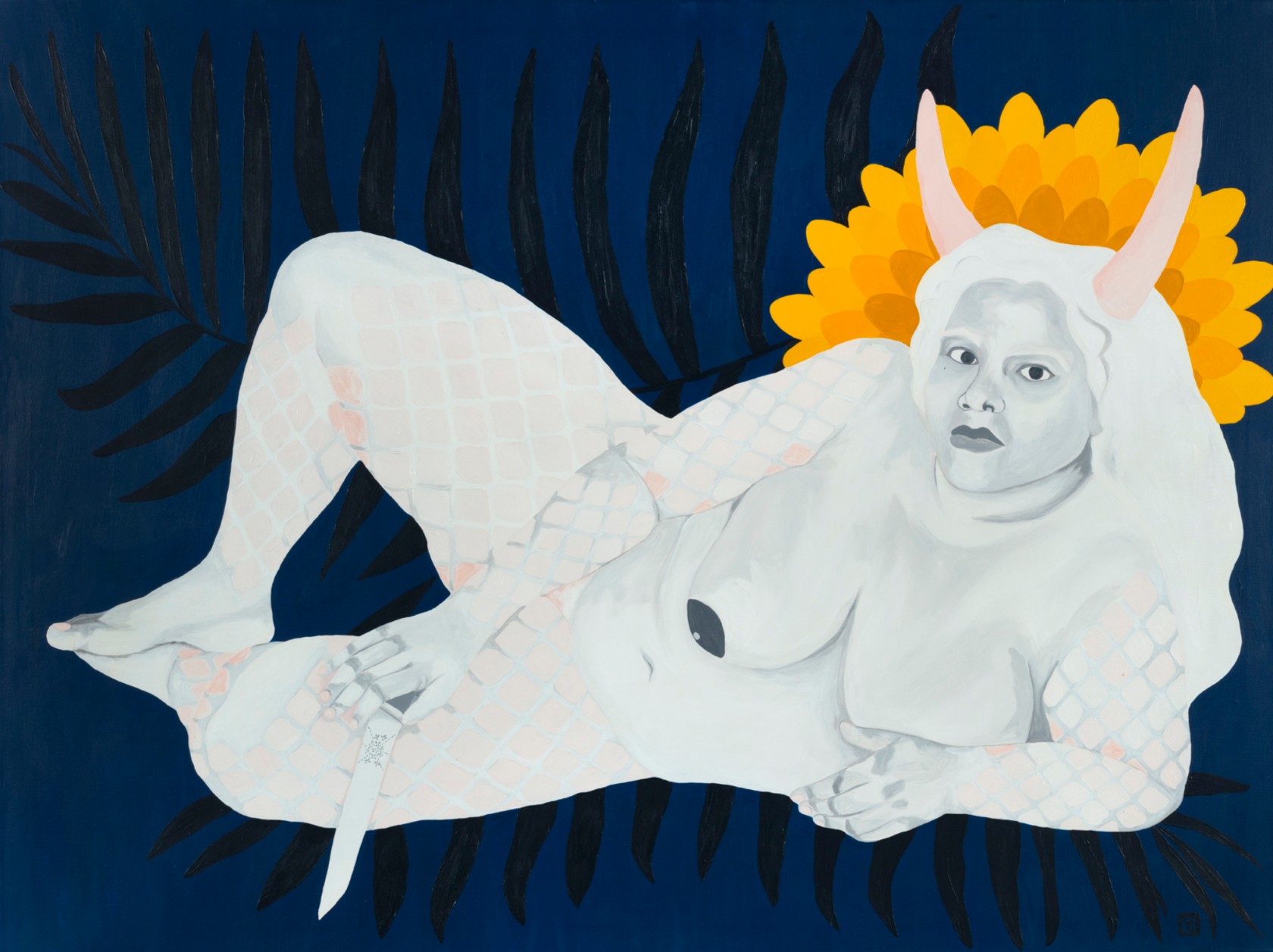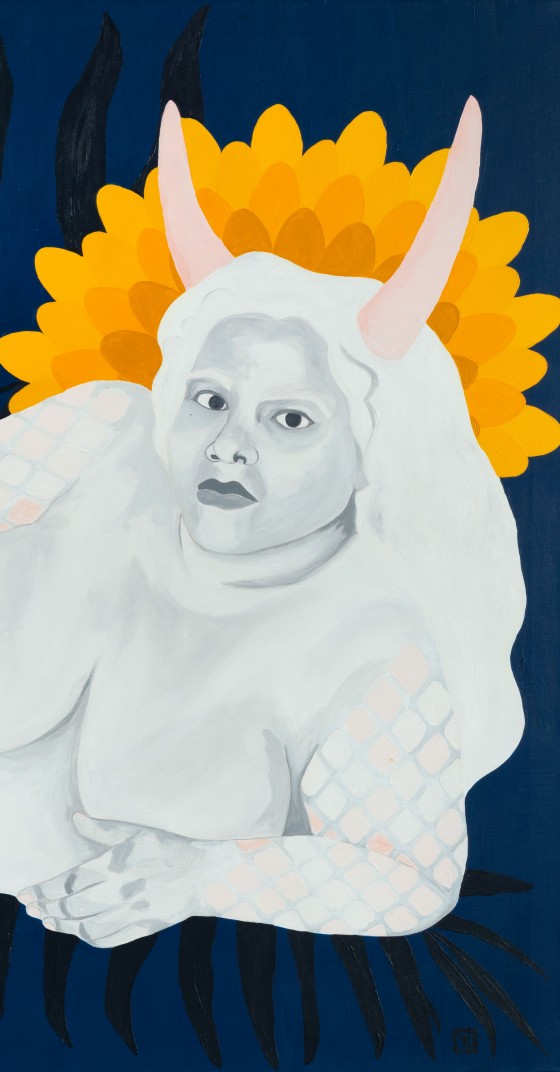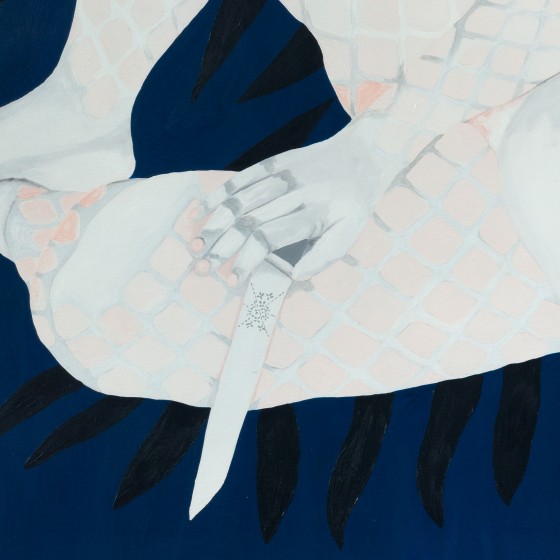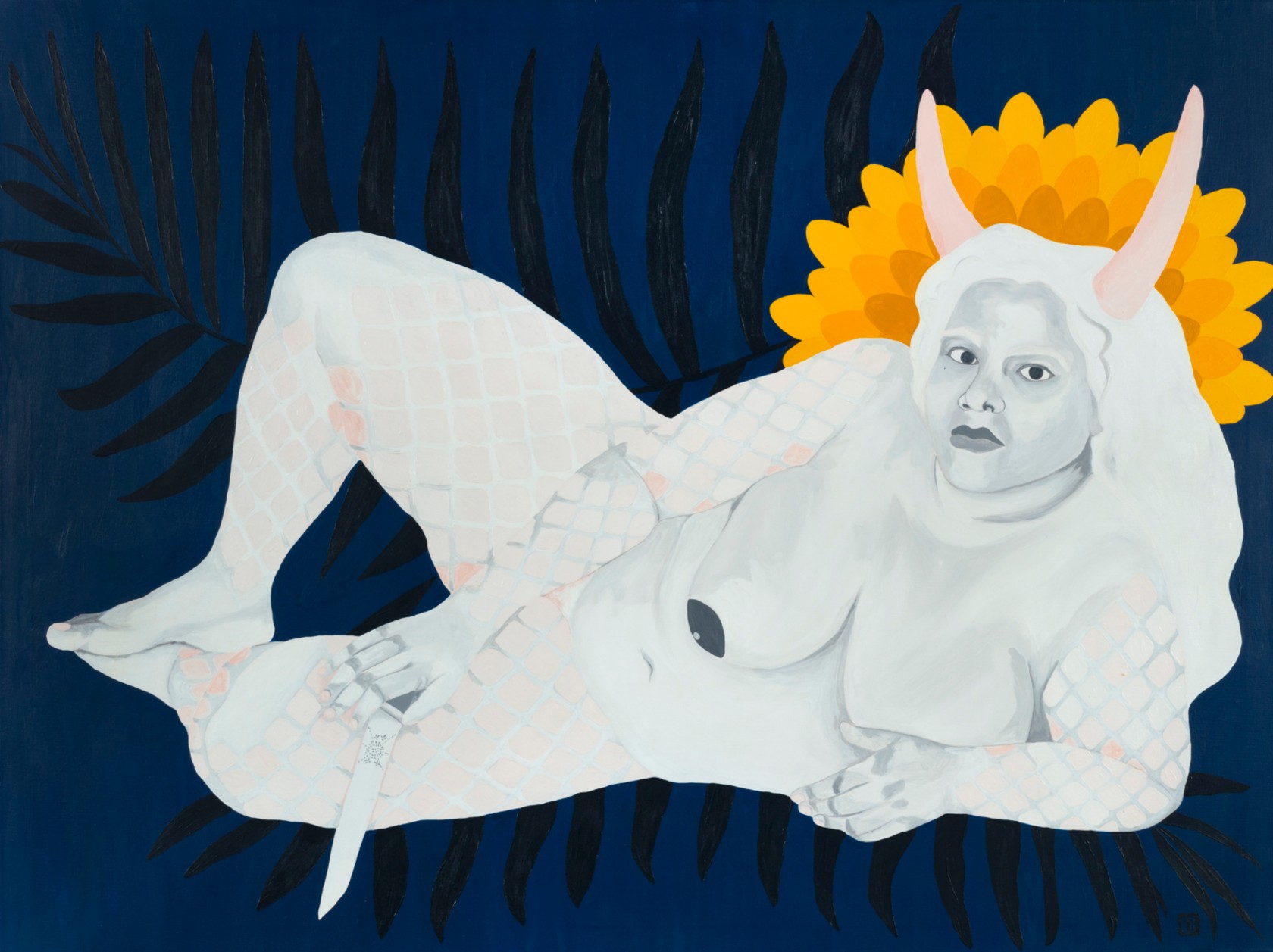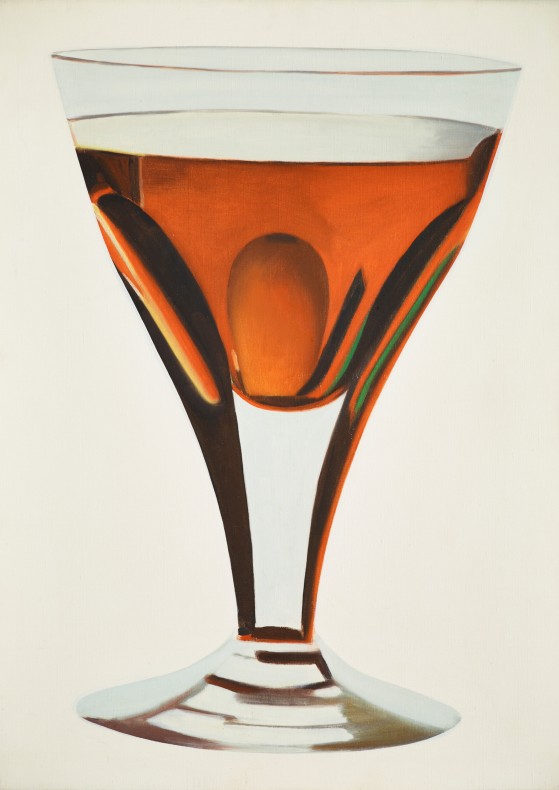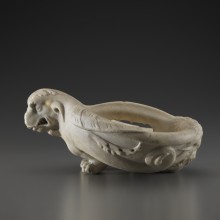
November 2021 African Contemporary Art and of the Diaspora
L’Épouse by Tessa Mars
In Tessa Mars’s painting entitled L’Épouse, we stand in front of a woman’s naked body laying horizontally on a dark blue background which features a palm leave that balances the composition and the position of the figure. On her head, two horns stand out on the background of a crown of petals made of three different layers of yellows, which leads our eyes directly to hers. Her body is white, with some light-pink touches and only her face, feet and chest aren’t covered by what appear to be scales. Although she offers herself to the eye in a relaxed position, she holds a knife in her right hand and seems ready to defend herself or attack.
See the artwork in the collectionTessa MARS (Port-au-Prince, Haiti, 1985)
L’Épouse
2017
Acrylic on canvas
91,4 x 122 cm
FGA-ACAD-MARS-0001
PROVENANCE
Piasa, Paris, 19 October 2017, lot no. 83
Self-portrait as a means of self-assertion?
Tessalines, a name resulting from the contraction of the artist’s first name Tessa with the family name of Jean-Jacques Dessalines, a Haitian Revolutionary celebrated as a key figure of Haiti’s independence, is a character derived from the artists herself and from her body, with which she plays in a series of works. Through this character, she embodies and interprets a potential being, a fiction as well as an unknown individual, despite being an alter-ego of sorts. Tessalines is a woman whose story can be imagined, told, depicted but that remains largely undocumented, or maybe has just not yet been sought after. Indeed, as Myriam Paris explains in her thesis Nous qui versons la vie goutte à goutte: “traces of fights that were not acknowledged as important are structurally erased, including by actors of these fights and their allies”1.
But how could one qualify this artwork? Is this a portrait? A self-portrait? Or does it have nothing to do with both of these practices?
Indeed, in the different traditions that inhabit art history’s genres in Western painting, portraiture refers to a major one – and goes back to the Antiquity as the Fayoum portrait of the Fondation Gandur pour l’Art testifies. Portraiture has been described, on the one end, as a gesture of conscious otherization or objectification, between the artist and his or her model. The artist represents indeed another body than his self-one. On the other end, portraiture not as representation of the other but as self-representation probably emerges in the German Renaissance (with a self-portrait by Albert Dürer) and a need for affirmation emerging from artists2. Of course, artists’ practices did not include only their own selves as central objects, unlike what the contemporary art practice that we will have a closer look at tend to do. It was more an experience for posterity but also an exercise in looking at oneself, at length, in the mirror and of sometimes diverting the facial features to express a mood or a personality. Portrait and self-portraiture are also, since the very beginning of this practices’ emergence, produced with the aim of inscribing a person in a sociological and defined group (aristocratic, revolutionary, cultural etc). While doing so, it calls for different types of posterity3.
A “rewriting of the self on the body”
From the Renaissance until the 20th century, most of the painters belonged to a relatively homogenous group: European, from a rather healthy social class, and, for the vast majority of them, white men. There were multiple non-white models, particularly black models4, mainly depicted in subaltern conditions, but also Orientalized Arabs5. Nonetheless, only a minority of the people out of the mentioned dominant social framework could access recognition as painters, artists and portraitists.
Yet it seems that Tessa Mars’s work is inscribed in a rather different dynamic. While in her painting the self is represented (L’Épouse is actually based on her self-portrait), one could actually consider the work as a rewriting more than a social positioning. “The process consists of the artist taking his [or her] own body as the “canvas”, light-sensitive “frame” or “screen”, so that the work of translation and re-appropriation is literally a kind of “re-writing of the self on the body”, a re-epidermalization, an auto-graphy”, as Stuart Hall puts it regarding the representation of black bodies regarding the legacy of Frantz Fanon’s thinking6.
Tessalines can then be seen as an informed fiction, made possible by oral transmission, a case-study of the Haitian Revolution and lived experience of the artist Tessa Mars. Using her own body in multiple paintings, the artist explores this idea with narratives surrounding the Haitian Revolution and her own story as a Caribbean woman. Her re-writing of the self on the body invokes black feminist traditions that rose in the 18th century against colonial powers.
Tessa Mars’s work is also strongly inspired by voodoo iconography. If she paints her own body white, it is not so much to express a creolization7 and it is not at all to refer to the western canons of representation, but to evoke voodoo figures, the remnant group of Guédé ancestors8. Of this “re-writing of the self on the body”, one can easily understand a re-inscription, a writing which implies a new reflection, a narrative that is, in our case-study at least, beside the hegemonic one.
“When I created Tessalines in 2015, my intention was to be able to tell my story my own way. It allowed me to have an external look at myself. It is a re-writing in which I am stronger. Tessalines changed me as well. The more my vision of what she is changes, the more I change as well. I see her as a mirror now, a subject in which I can project myself. But in return she judges me. She pushes me to change. We are in a constant change, a fusion, a metamorphosis. We are becoming hybrid. She is a heroical version of myself. I project force and stubbornness on her. She takes necessary action, that is why she is armed most of the time. But what does she protect me from? As a woman, being constantly harassed, and as a black woman from the Caribbean living in a sexist society with so many fights to fight, she protects me from all these difficulties.”9
With Tessalines she also refers ambiguously to the celebrated Haitian figure of Independence: Jean-Jacques Dessalines. After fighting for the French Revolution, he then enrolled very early in the fight against slavery and the French colonial empire back in Haiti. In 1804, he led his armies towards independence from the colonial empire and declared himself “life-time general governor” (gouverneur-général à vie). He subsequently became the emperor of Haiti based on former colonial models10, re-created a Haitian noble cast, a system of labor hard on workers and declared French the official language despite the majority of the population speaking creole. Eventually he got assassinated in 1806 and his family was evicted from the island. Still, he is to this day considered a father-figure of the island. He is the model of an enslaved man who later was in power and imposed an order and a political system similar to the colonial ones. Cécile Fatiman for example, also closely associated with the first slave revolt, does not hold such a place in national history.
At once present, past and future
It is partly from these different observations that emerges the figure of Tessalines. But instead of making claims on heroic figures and perpetuating a writing of history that includes key figures and that forgets other discriminated ones – history is written by the victors has become a trope – she ironically includes her own body in her story. With this gesture, rather than underlining concrete facts whilst looking at Haiti’s history, Tessa Mars introduces the idea of fiction, of a re-writing of history and raises many important questions that have partly been ignored and now remain important: what is this emphasis on historical heroes saying of a conception of the past and history as a discipline? What is at the root of our culture really? How am I (or not) in relation with that? How is my body the result of socio-historical and material processes that are visible in the public space and why?
Tessa Mars uses her body as a ship to navigate new epistemological waters. The body is a methodological vessel towards a different understanding of the world, whilst at the same time being the visible stigma of our world’s organization and in her case of the deportation of Africans to the Caribbean during the Atlantic slave trade. The author, is claiming a right on the production itself – the painting. Although she builds a criticism addressed more directly to a specific area and population and a political power in Haiti, she nevertheless invites us to think our relation to public figures and celebrated personalities. By using her own image to embody a Guédé ancestor, she also blurs the boundaries of time, and calls for a non-linear vision of history. “Once perceptions of time are emancipated from narrative beginnings and endings, to embrace instead a pluriverse of becoming, we recognize why angels and ghosts have loomed so large in black diaspora arts. Because they are time travelers, interrupting borders that ordinarily separate past, present, and future, […]”11, would argue the art historian Kobena Mercer, in a sentence that permits us to put in perspective the disruptions at work in Tessa Mars’s painting.
Olivia Fahmy
Curator of the collection of African Contemporary Art and of the Diaspora
October 2021
Notes and references
- PARIS, Myriam, Nous qui versons la vie goutte à goutte : féminismes, économie reproductive et pouvoir colonial à La Réunion, Paris : Dalloz, Nouvelle Bibliothèque de Thèses, 2020, p. 36.
- See FREELAND, Cynthia, “Portraits in Painting and Photography”, Philosophical Studies: An International Journal for Philosophy in the Analytic Tradition, Vol. 135, No. 1, August 2007 [Proceedings of the Thirty-Seventh Oberlin Colloquium in Philosophy: Aesthetics], p. 98.
- BORDES, Philippe, “Interpreting Portraits: Images of Society or the Self?”, Studies in the History of Art, Vol. 74, 2009, p. 304-315, p. 313; “Historical conceptions of the self suggest the need to address its bodily and reflexive dimensions, but also the dimension forged by social and cultural interactions. The term self-portrait, a misnomer compared to the less substantial French term of autoportrait, distorts all discussion from the start. In such a painting, individual psychological traits might indeed be inscribed in the paint (…) the production of a self-portrait was fundamentally a socially exteriorizing cultural practice, as Clark has stressed. In this respect, a self-portrait can always be considered the image of a group” as the French art historian Philippes Bordes argues.
- See VER-NDOYE, Nail, FAUCONNIER, Grégoire, Noir : entre peinture et histoire, Paris : Omniscience, 2018.
- Starting in the 19th century, See SAID, Edward W., L'Orientalisme. L'Orient créé par l'Occident, Paris: Éditions du Seuil, 2005 [1978].
- HALL, Stuart, “The After-Life of Frantz Fanon: Why Fanon? Why now? Why Black Skin Whites Masks?” in READ, Alan, et alii, The Fact of Blackness. Frantz Fanon and Visual Representation, London: Institute of Contemporary Art Publications; Seattle: Bay Press, 1996, p. 20.
- Word built by the Jamaican historian E. K. Brathwait, in short, to describe a multicultural society in the Antilles. See MENIL, Alain, “La créolisation, un nouveau paradigme pour penser l’identité ?“, Collège International de Philosophie | Rue Descartes, No. 66, 2009, p. 10.
- Interview with Tessa Mars, February 2020.
- Mars, Tessa, Interview in the context of her exhibition at Le Centre d’art Haiti [en ligne], 2019, available on: https://www.facebook.com/watch/?v=2272030432851915. (consulted on the 06.03.2021).
- GIRARD, Philippe R., “Jean-Jacques Dessalines and the Atlantic System: A Reappraisal”, The William and Mary Quarterly, Vol. 69, No. 3, July 2012, p. 554.
- MERCER, Kobena, Travel & See: Black Diaspora Art Practices since the 1980’s, Durham: Duke university Press, 2016, p. 32.
Bibliography
BORDES, Philippe, “Interpreting Portraits: Images of Society or the Self?”, Studies in the History of Art, Vol. 74, 2009, p. 304-315.
GIRARD, Philippe R., “Jean-Jacques Dessalines and the Atlantic System: A Reappraisal”, The William and Mary Quarterly, Vol. 69, No. 3, July 2012.
FREELAND, Cynthia, “Portraits in Painting and Photography”, Philosophical Studies: An International Journal for Philosophy in the Analytic Tradition, Vol. 135, No. 1, August 2007 [Proceedings of the Thirty-Seventh Oberlin Colloquium in Philosophy: Aesthetics].
GREANI, Nora, « Soixante ans de création à l’École de peinture de Poto Poto (Congo-Brazzaville) », Cahier d’études africaines, No. 205, 2012, p. 259-267.
HALL, Stuart, “The After-Life of Frantz Fanon: Why Fanon? Why now? Why Black Skin Whites Masks?” in READ, Alan, et alii, The Fact of Blackness. Frantz Fanon and Visual Representation, London: Institute of Contemporary Art Publications; Seattle: Bay Press, 1996.
MARS, Tessa, Interview in the context of her exhibition at Le Centre d’art Haiti [online], 2019, available on: https://www.facebook.com/watch/?v=2272030432851915. (consulted on the 06.03.2021).
MENIL, Alain, “La créolisation, un nouveau paradigme pour penser l’identité ?“, Collège International de Philosophie | Rue Descartes, No. 66, 2009.
MERCER, Kobena, Travel & See: Black Diaspora Art Practices since the 1980’s, Durham: Duke university Press, 2016
PARIS, Myriam, Nous qui versons la vie goutte à goutte: féminismes, économie reproductive et pouvoir colonial à La Réunion, Paris : Dalloz, Nouvelle Bibliothèque de Thèses, 2020.
SAID, Edward W., L'Orientalisme. L'Orient créé par l'Occident, Paris : Éditions du Seuil, 2005 [1978].
VER-NDOYE, Nail, FAUCONNIER, Grégoire, Noir : entre peinture et histoire, Paris : Omniscience, 2018.

